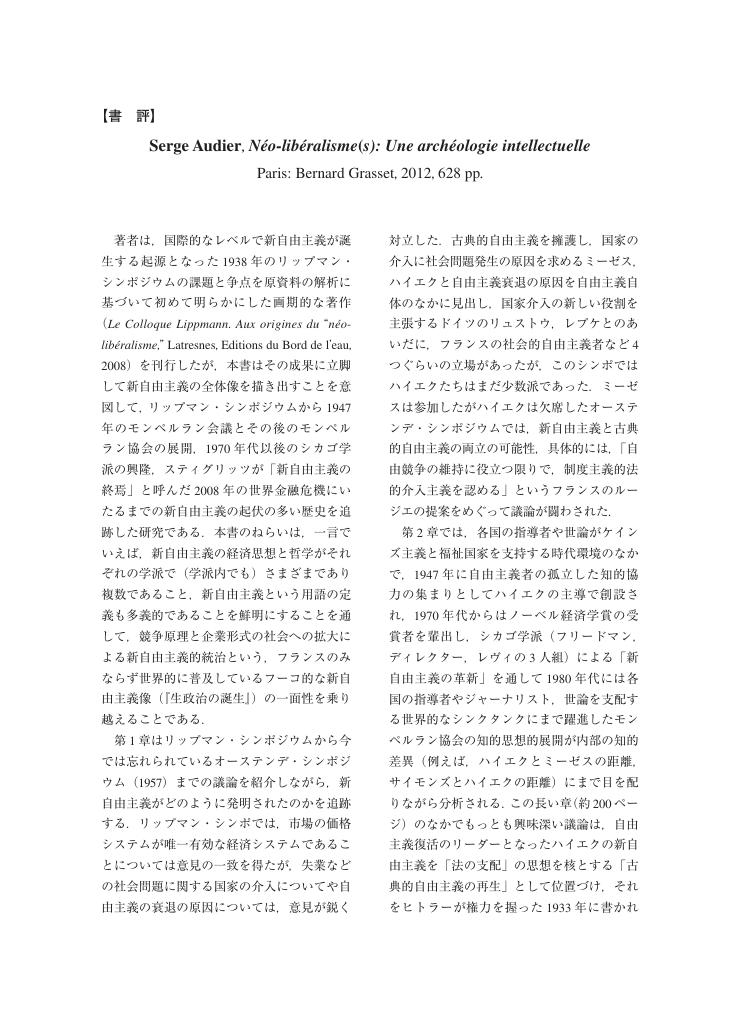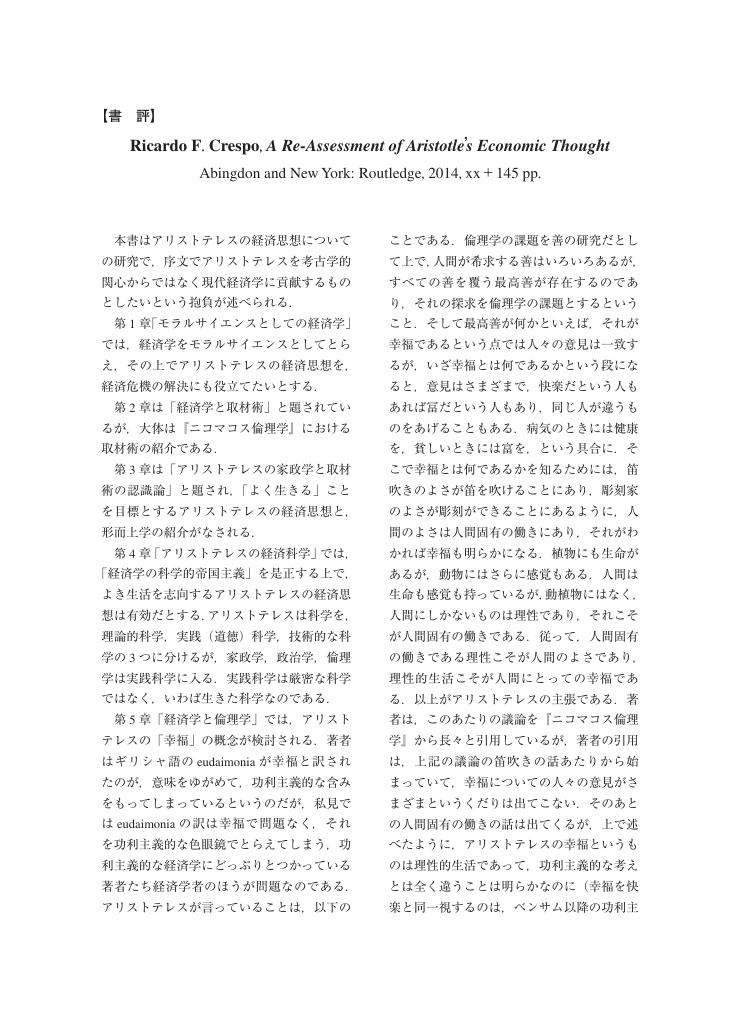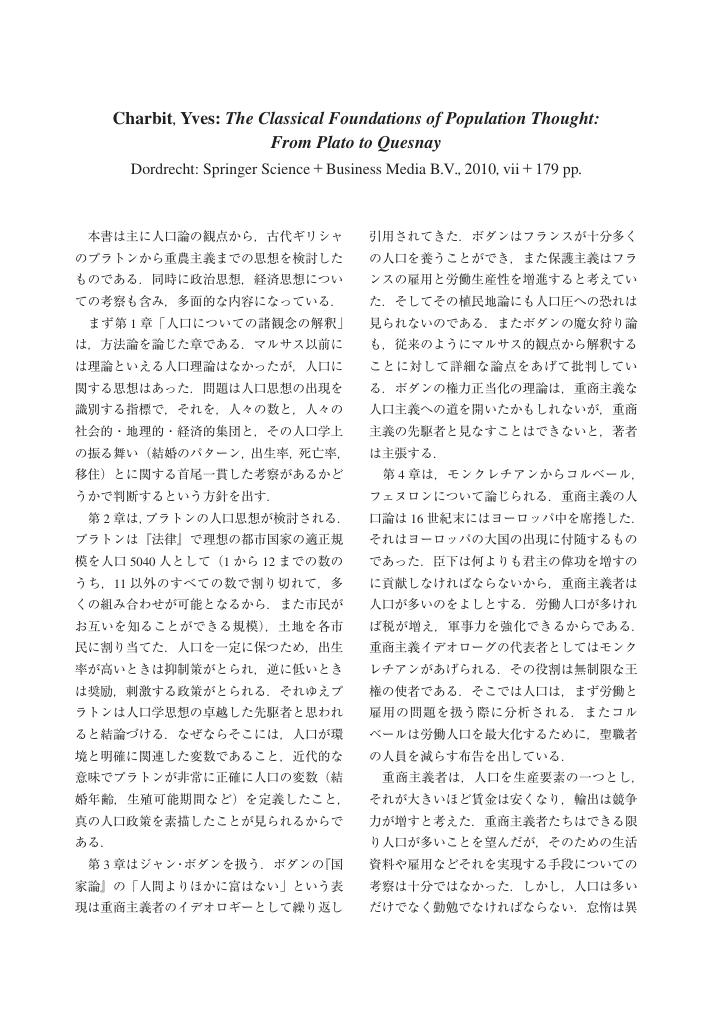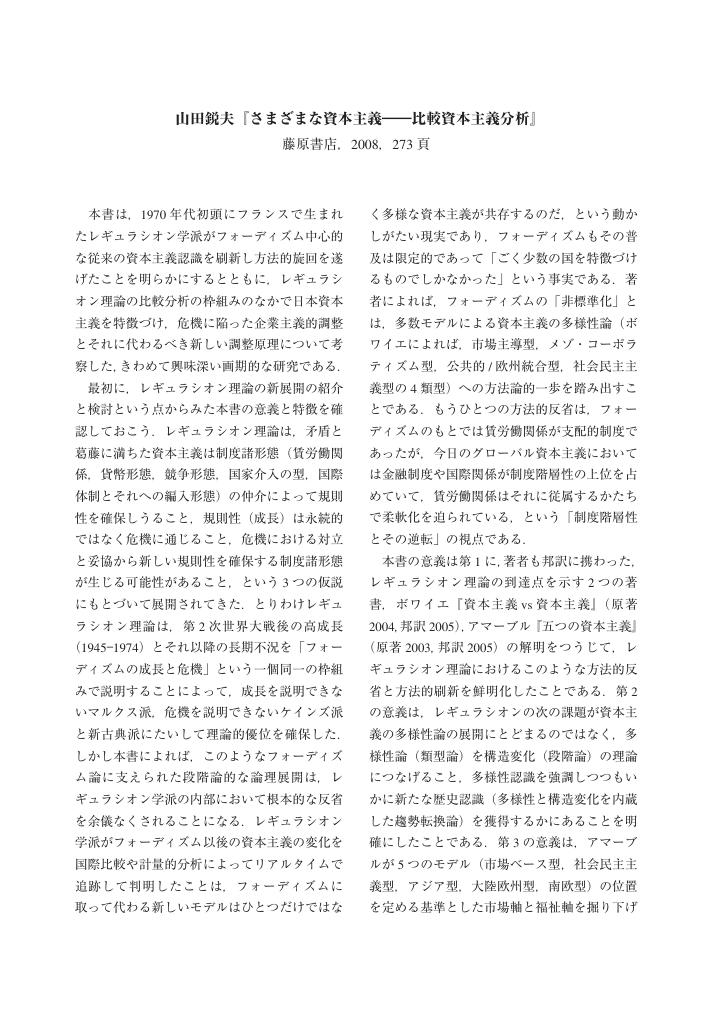1 0 0 0 OA プロティノスに於ける英知的素材と英知の直知作用について
- 著者
- 森本 聡
- 出版者
- 宗教哲学会
- 雑誌
- 宗教哲学研究 (ISSN:02897105)
- 巻号頁・発行日
- vol.9, pp.106-119, 1992 (Released:2018-03-21)
Intelligible Matter, which derives from Plato’s Indefinite Dyad, is adopted and developed by Plotinus. But it is not clear what position it has in his whole system, whose ‘pivot’ is the theory of Spiritual Intuition or Contemplation. This paper will throw light on what it is and how related to the Spiritual Intuition of Intelligence. There are two reasons Plotinus supposes Intelligible Matter in the Intelligible World; (i) Forms there have particular characteristics which distinguish them one from another. So there must be something which receives and unifies them, and this ‘something’ must be Intelligible Matter. (ii) Intelligence is unlimited when it proceeds from the One, and it begins to behold itself and constitutes the World of Forms by being defined and informed by it. That which is limited by forms is matter. So Intelligence must have Intelligible Matter as the essential part of its constitution. Intelligence beholds the World of Forms by beholding itself. So it is ‘one-many.’ But it also has a higher aspect of Spiritual Intuition which can grasp the One as it is and receive the Formative Principle from it. This higher Spiritual Intellection has four functions; (i) it makes Intelligence proceed from the One, (ii) it makes Intelligence be informed and limited by the One, (iii) it makes Intelligence maintain the unity of the Intelligible World, and (iv) it makes Intelligenece return to the One. Of these four functions it has the second and the third in common with Intelligible Matter. Without them, it also would be meaningless. So it contains Matter of the Intelligible World as the essential element of its structure. And the other is valid only when it is connected with the higher Spiritual Intuition.
1 0 0 0 OA 国際法秩序の断片化問題と統合への理論課題
- 著者
- 小森 光夫
- 出版者
- 世界法学会
- 雑誌
- 世界法年報 (ISSN:09170421)
- 巻号頁・発行日
- vol.28, pp.3-41, 2009-03-28 (Released:2017-11-22)
1 0 0 0 OA ハーシュ・ラウターパクトが残したもの 国際法の存在判断における意思と理由の文脈から
- 著者
- 小森 光夫
- 出版者
- 世界法学会
- 雑誌
- 世界法年報 (ISSN:09170421)
- 巻号頁・発行日
- vol.2001, no.20, pp.107-130, 2001-01-30 (Released:2011-02-07)
- 参考文献数
- 58
- 著者
- 若森 章孝
- 出版者
- 経済学史学会
- 雑誌
- 経済学史研究 (ISSN:18803164)
- 巻号頁・発行日
- vol.60, no.1, pp.207-208, 2018 (Released:2019-11-05)
1 0 0 0 OA カール・ポランニー研究の新地平と課題 Gareth Dale の 3 冊の書籍を読んで
- 著者
- 若森 みどり
- 出版者
- 経済学史学会
- 雑誌
- 経済学史研究 (ISSN:18803164)
- 巻号頁・発行日
- vol.60, no.1, pp.179-188, 2018 (Released:2019-09-03)
- 著者
- 若森 章孝
- 出版者
- 経済学史学会
- 雑誌
- 経済学史研究 (ISSN:18803164)
- 巻号頁・発行日
- vol.58, no.2, pp.86-88, 2017 (Released:2019-11-30)
- 著者
- 南森 茂太
- 出版者
- 経済学史学会
- 雑誌
- 経済学史研究 (ISSN:18803164)
- 巻号頁・発行日
- vol.58, no.2, pp.63-65, 2017 (Released:2019-11-30)
1 0 0 0 OA Ryu Susato, Hume’s Sceptical Enlightenment. Edinburgh: Edinburgh University Press, 2015, xii+348 pp.
- 著者
- 森 直人
- 出版者
- The Japanease Society for the History of Economic Thought
- 雑誌
- 経済学史研究 (ISSN:18803164)
- 巻号頁・発行日
- vol.58, no.2, pp.48-50, 2017 (Released:2019-11-30)
1 0 0 0 OA On Takahira Kanda’s 'the People'
- 著者
- 南森 茂太
- 出版者
- 経済学史学会
- 雑誌
- 経済学史研究 (ISSN:18803164)
- 巻号頁・発行日
- vol.57, no.2, pp.46-67, 2016 (Released:2019-08-30)
Abstract: The purpose of this article is to show that Takahira Kanda’s( 1830―98) evaluation of “the people” was closely related to his political and economic reform plans. Since the early 19th century, ships from American and European countries had been coming to Japan, and the Tokugawa Shogunate felt compelled to reinforce their armaments. In order to raise the vast funds necessary for reinforcement, the shogunate tried to promote various domestic industries. The Meiji Government that later overthrew the shogunate also succeeded in such promotional policies. Thus, “the modernization” policies of the government spread to several fields, and the top governmental officials, bureaucrats, and western scholars presented numerous modernization plans, most of them insisting that the government carry out various reforms. However, they believed that “the people” were “ignorant” and did not have the ability to be involved with such reforms. On the other hand, Kanda evaluated “the people” as political and economic subjects. Such ideas had already appeared by the end of the shogunate. In Nosyoben( 1862), Kanda insisted that “the people” are independent economic subjects with political interest; he succeeded to gain recognition for his thoughts after the Meiji Era. Thus, the idea of the assembly and patent systems in Japan was based on the recognition of his thoughts. In order to carry out his reform plans, Kanda had to wipe out the evaluation of people made by the top governmental officials and bureaucrats and hence made his reform plans public through magazines and newspapers. His activities were closely watched by the top governmental officials, and finally the Meiji government managed to weaken his influence. However, his thoughts contributed much to the pioneering achievement of “the local notable theory” during the middle of the Meiji Era. JEL classification number: B 31.
1 0 0 0 OA 河野有里『田口卯吉の夢』慶應義塾大学出版会,2013年,ix+325+10頁
- 著者
- 南森 茂太
- 出版者
- 経済学史学会
- 雑誌
- 経済学史研究 (ISSN:18803164)
- 巻号頁・発行日
- vol.56, no.2, pp.141-142, 2015 (Released:2019-11-30)
- 著者
- 若森 章孝
- 出版者
- 経済学史学会
- 雑誌
- 経済学史研究 (ISSN:18803164)
- 巻号頁・発行日
- vol.56, no.2, pp.125-126, 2015 (Released:2019-11-30)
- 著者
- 森岡 邦泰
- 出版者
- 経済学史学会
- 雑誌
- 経済学史研究 (ISSN:18803164)
- 巻号頁・発行日
- vol.56, no.2, pp.127-128, 2015 (Released:2019-11-30)
- 著者
- 森 直人
- 出版者
- 経済学史学会
- 雑誌
- 経済学史研究 (ISSN:18803164)
- 巻号頁・発行日
- vol.54, no.2, pp.90-91, 2013 (Released:2019-10-31)
- 著者
- 森下 宏美
- 出版者
- 経済学史学会
- 雑誌
- 経済学史研究 (ISSN:18803164)
- 巻号頁・発行日
- vol.54, no.2, pp.94-95, 2013 (Released:2019-10-31)
- 著者
- 若森 みどり
- 出版者
- 経済学史学会
- 雑誌
- 経済学史研究 (ISSN:18803164)
- 巻号頁・発行日
- vol.54, no.2, pp.83-85, 2013 (Released:2019-10-31)
- 著者
- 森岡 邦泰
- 出版者
- The Japanease Society for the History of Economic Thought
- 雑誌
- 経済学史研究 (ISSN:18803164)
- 巻号頁・発行日
- vol.53, no.2, pp.108-109, 2012 (Released:2019-10-30)
- 著者
- 南森 茂太
- 出版者
- 経済学史学会
- 雑誌
- 経済学史研究 (ISSN:18803164)
- 巻号頁・発行日
- vol.52, no.1, pp.106-107, 2010 (Released:2019-10-25)
1 0 0 0 OA 山田鋭夫『さまざまな資本主義―比較資本主義分析』 藤原書店,2008,273 頁
- 著者
- 若森 章孝
- 出版者
- 経済学史学会
- 雑誌
- 経済学史研究 (ISSN:18803164)
- 巻号頁・発行日
- vol.51, no.2, pp.124-125, 2009 (Released:2019-08-08)
1 0 0 0 OA カール・ポランニーの「経済社会学」の誕生 『大転換』から『人間の経済』へ
- 著者
- 若森 みどり
- 出版者
- 経済学史学会
- 雑誌
- 経済学史研究 (ISSN:18803164)
- 巻号頁・発行日
- vol.51, no.2, pp.33-50, 2009 (Released:2019-08-08)
- 参考文献数
- 50
1 0 0 0 OA モンテスキュー『法の精神』における「シヴィルcivil」概念の二重性
- 著者
- 定森 亮
- 出版者
- The Japanease Society for the History of Economic Thought
- 雑誌
- 経済学史研究 (ISSN:18803164)
- 巻号頁・発行日
- vol.49, no.1, pp.19-36, 2007-06-30 (Released:2010-08-05)
- 参考文献数
- 21
In The Spirit of the Laws Montesquieu discusses two important regimes from the perspective of the historical formation of the realm of the “civil”: on the one hand England, and on the other, the French monarchy. In the case of the former, with regard to the formation of the “civil, ” he recognizes the emergence of republican government through the development of commercial society from the end of the 15th to the latter half of the 17th century. In the case of the French monarchy, the “civil” developed in context of the formation of feudal society itself, principally from the decline of the Roman Empire to the end of the 10th century; it was this period that gave birth to the class of nobility that sustained the juridical system and constituted the intermediate power in this regime. Here, present a clear, explicit statement of the objectives and argument of the paper.In this context, a comparison between Montesquieu and James Harrington appears to have crucial meaning for the reconsideration of republicanism, which is usually thought to be inherited from Greco-Roman tradition. Harrington, in The Commonwealth of Oceana, wants to revive ancient republics in the modern world and presents a theoretical model for contemporary 17th-century England. In contrast to Harrington, Montesquieu, in a more strictly historical approach, traces the foundations of both the contemporary English and French regimes back to feudal society and there finds the origin of institutions such as the representation system and independent judicial power, which form the basis of moderate government in both countries. In this context, Montesquieu situates the German tribes especially as described by Caesar and Tacitus at the starting point of feudalism.Montesquieu attempts to demonstrate that modern Europe was formed after the decline of Roman Empire through a process of historical contamination from both Roman and German inheritances, and it is through this perspective that we can reconsider the above-mentioned republicanism, whose genealogy until now has been limited to the Greco-Roman tradition.
















